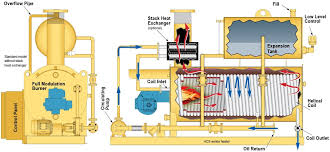
Dec . 07, 2024 12:48 Back to list
steam boiler temperature and pressure
Understanding Steam Boiler Temperature and Pressure
Steam boilers are essential components in numerous industrial processes, power generation, and heating systems. They operate by converting water into steam through heating, which can then be used to drive turbines, generate electricity, or provide thermal energy for various applications. The efficiency and safety of a steam boiler significantly depend on the temperature and pressure of the steam generated. This article explores the relationship between steam boiler temperature and pressure, how they are measured, and their implications on boiler performance.
The Basics of Steam Boilers
At its core, a steam boiler is a closed vessel where water is heated, typically using combustion of fuels like natural gas, oil, or coal. The heat generated increases the temperature of the water until it transforms into steam. Typically, the boiling point of water is 100°C (212°F) at atmospheric pressure. However, in a boiler, the pressure is often increased, allowing the water to boil at higher temperatures, which enhances the performance and energy efficiency of the system.
The Relationship Between Temperature and Pressure
The interrelationship between steam temperature and pressure can be understood through the principles of thermodynamics, specifically the properties of water and steam. According to the steam tables, an increase in pressure directly correlates with an increase in boiling point temperature. For instance, at a pressure of 1 bar (approximately atmospheric pressure), the boiling point of water is 100°C. However, at a pressure of 10 bar, the boiling point rises to around 180°C (356°F). Thus, within a steam boiler, higher pressures are typically employed to achieve higher steam temperatures, improving the overall efficiency of the heating process.
Importance of Monitoring Temperature and Pressure
steam boiler temperature and pressure

Monitoring and controlling the temperature and pressure within a steam boiler is crucial for several reasons
1. Safety Steam boilers operate under high pressure and temperature, making them inherently risky. If pressure builds up beyond the safety limits, it can lead to catastrophic failures, including explosions. Safety valves and pressure gauges are therefore vital components of boiler systems.
2. Efficiency Maintaining optimal temperature and pressure conditions enhances the operational efficiency of a boiler. Higher temperatures and pressures typically allow for greater energy extraction from the fuel, improving the overall energy conversion ratio.
3. Quality of Steam The quality of steam often depends on its temperature and pressure. Superheated steam, which is steam at a temperature higher than its saturation point at a given pressure, is required for maximizing power generation efficiency in turbines.
4. Condensation and Corrosion Improper temperature and pressure settings leading to condensation can create water droplets within steam lines, risking corrosion, and damaging equipment. Monitoring ensures that steam remains superheated and dry, which helps in protecting system integrity.
Conclusion
In summary, understanding the relationship between steam boiler temperature and pressure is crucial for the safe and efficient operation of these systems. Engineers and operators must carefully monitor these parameters, employing appropriate safeguards and control mechanisms to maintain ideal conditions. By doing so, they ensure a reliable supply of steam for various applications while minimizing risks associated with high-pressure operations. As technology continues to advance, the monitoring and control of steam boiler systems will become even more sophisticated, promoting greater efficiency and safety in industrial processes.
-
High-Efficiency Commercial Oil Fired Steam Boiler for Industry
NewsJul.30,2025
-
High-Efficiency Biomass Fired Thermal Oil Boiler Solutions
NewsJul.30,2025
-
High Efficiency Gas Fired Thermal Oil Boiler for Industrial Heating
NewsJul.29,2025
-
High-Efficiency Gas Fired Hot Water Boiler for Sale – Reliable & Affordable
NewsJul.29,2025
-
High Efficiency Biomass Fired Hot Water Boiler for Industrial and Commercial Use
NewsJul.29,2025
-
High-Efficiency Biomass Fired Hot Water Boiler for Industrial Use
NewsJul.28,2025
Related PRODUCTS






















